Legend and history
Many legends and tales have been preserved about this amazing plant. According to this legend, the Christmas Star owes its name to children from a poor family. Traditionally, the Mexican poor would bring offerings to the newborn on Christmas Eve. But the children had nothing to give. Then they collected wild herbs, which magically turned into fabulously beautiful flowers at the cradle.

But the poinsettia flower was named after Joel Poinsett. The American ambassador to Mexico was an enthusiastic person, interested in the flora of the tropics. In 1825, he was the first to bring these brightly colored branches to one of the American states.
The cuttings successfully took root, and Joel named the plant euphorbia, after the name of the ancient philosopher and healer. But the people stubbornly stuck with the name poinsettia, which came from the name of the ambassador.
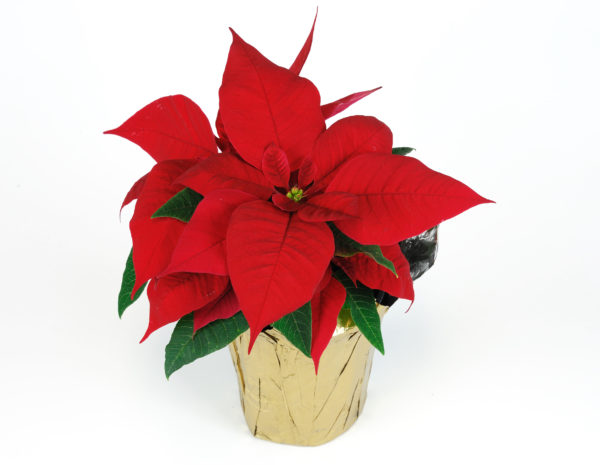
In the tropical forests of its homeland, this euphorbia shrub reaches a height of three meters.
In the new habitat, poinsettia does not reach such an impressive size and a small flower pot is enough for it.
Thanks to breeding work, many different varieties of milkweed have recently appeared. Their leaves of white, cream, pink, crimson, spotted color form an exquisite flower shape that resembles a star. But poinsettia, with its classic red leaf color, is still the leader among Christmas plants.
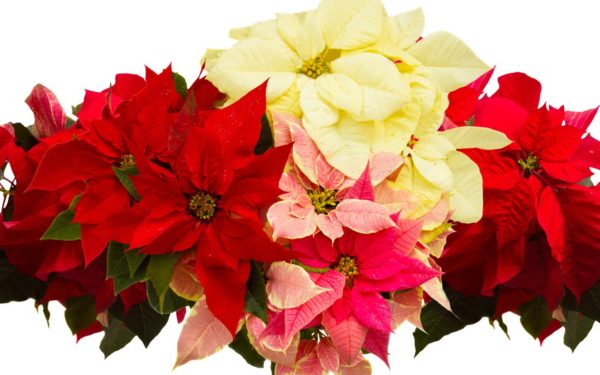
Euphorbia is often used as a seasonal green home decoration. Many consider this plant to be an annual and make no effort to preserve the flower. But by properly caring for poinsettia at home, you can annually rejoice at the miraculous transformation of the Star of Bethlehem.
Poinsettia: home care - reproduction, pruning, transplant, rest period
Reproduction
At home, poinsettia is propagated only vegetatively. In the spring, the apical cuttings are cut (each of them should have 5 internodes - about 15 cm in length) and put in warm water for 10-15 minutes. The milky juice released at the same time is dried with hygroscopic paper or cotton wool, the sections are powdered with charcoal powder. Prepared cuttings are rooted in water or in a substrate of equal parts of peat and sand. After that, the seedlings must be placed in a greenhouse or covered with a jar or bag. To accelerate the emergence of roots, stimulants are used - root, heteroauxin. The optimum temperature for rooting is + 24-28 ° C. The plantings are periodically moistened and aired. After about 3-4 weeks, roots appear, active growth begins. After 2 weeks after rooting, you can start fertilizing young plants. For better tillering, the shoots are pinched over 5-6 leaves. Such procedures are carried out regularly to give the bush a compact shape. For uniform development of the crown, periodically the pot with the plant must be turned. The grown seedlings are transferred into separate pots.
Pruning
In the spring (in March), the poinsettia begins an active growth of new shoots. So that the spurge does not stretch out and does not "go bald", but has a compact shape, formative pruning is carried out. Weak shoots are removed on the plant, the remaining strong stems are cut by 1/3. The cut pieces are used for rooting. After that, the spurge is placed in a bright place to stimulate the growth of new shoots.
New shoots appeared on the trimmed poinsettia
As soon as they grow up to 10-12 cm, they are pinched.This procedure promotes tillering of the plant: the more branches on it, the more flowers will turn out later - poinsettia blooms only on new shoots.
Transfer
It is better to replant poinsettia in spring, when new shoots will grow after pruning. A new pot is taken a little more than the previous one (if inserted into each other, then the gap between them must be 1-1.5 cm). Drainage must be done in the pots.
Dormant period
The poinsettia has a pronounced dormant period. Its duration is 2 months. During this period, watering is reduced, but without allowing the soil to completely dry out. The plant is kept at a temperature of + 12-14 ° C.
Attention! When carrying out cuttings, you should be careful: poinsettia juice is poisonous and can cause irritation of the skin, gastrointestinal tract, hay fever. Therefore, all manipulations with milkweed are best done with gloves.
Varieties of poinsettia
Specialists have bred several types of Christmas stars, they differ in the color of the bracts, the shape of the leaves.
Here are the most common varieties:
The classic look is recognizable by the bright red color of the tops. Such flowers are popular in Europe, they include Eckespoint Freedom Red and Mars poinness.
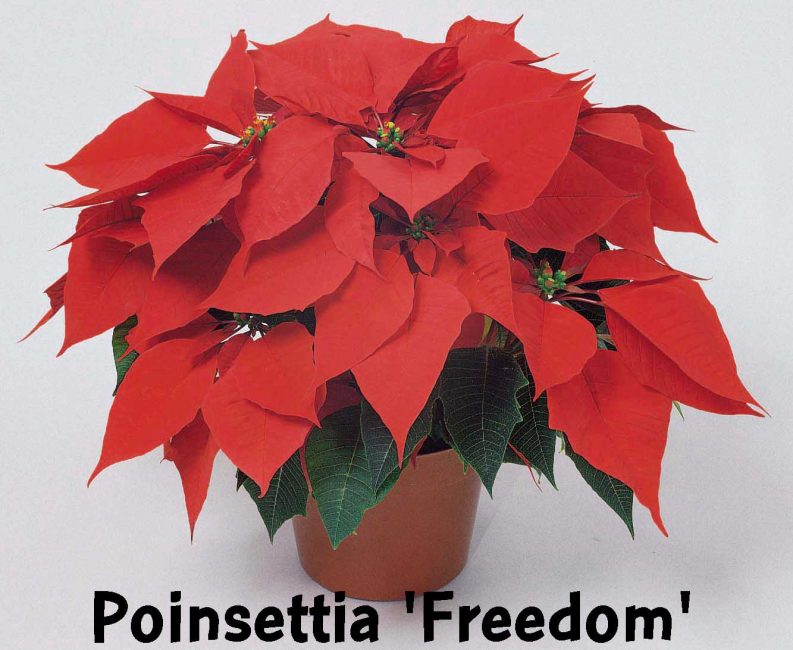
Freedom with red tops
A sophisticated variety, which is constantly growing in popularity in Russia, with light tops. The bracts are white or light yellow, the size of the leaves is large, the surface is glossy. The most prominent representatives of light poinsettia are Cortez White, Enduring White, Whitestar, Regina.

Blooming Cortez White
Pink bracts have varieties Amazon Peppermint, Strawberry and cream, Silverstar Marble, Peterstar. Their color intensity is different, Peterstar has the brightest tops.

Pink Peterstar in active flowering stage
Variegated varieties Silverstar Marble, Sonora, Sonora White, Monet Twilight, Marblestar, Jingle Bells Sonora have multi-colored bracts. Veins can be white, light yellow, light green. The varieties are highly decorative.

Blooming Sonora with light yellow blotches
Poinsettia
Features of caring for a Christmas star.
- TOP 20 plants blooming in July: what should you choose for a garden, vegetable garden or flower bed? (Photo & Video) + Reviews
- Bulbous Flowers Catalog: Description 21 Varieties, for growing in the open field and at home (65 Photos & Videos) + Reviews
- Perennial flowers (33 main types): a garden catalog for a summer residence with photos and names (Video) + Reviews
- TOP-50 Ornamental plants that purify the air in our house or apartment (50+ Photos & Videos) + Reviews
7.9
Total Score
Summary
If you want to add a little brightness to gray everyday life, then put a blooming poinsettia on your window. The plant will delight with its flowering for about 2 months, and with proper care, even longer.
Ease of care
6.5
Appearance
8
Bloom
8
Originality
9
Care
After the purchase
Poinsettia care begins immediately after purchase. Therefore, the first thing you need to do is put the flower on a lighted windowsill, protected from drafts - there it will get used to the new place of residence in the next 3 weeks. In addition, such a quarantine is needed for protection: if pests are found on the poinsettia, they will not move to other house plants.
Another nuance is the store soil. Experienced flower growers know that it is a kind of transit point for flowers and they cannot grow for a long time in an acidic environment. Therefore, the second step is transplanting into a new pot with fresh soil.
Priming
Choose a slightly acidic loose substrate for your home "star". Ideal: a combination of peat, sand, turf and leafy soil in a ratio of 1: 1: 3: 3. Add a handful of humus as well. Drainage - river pebbles, expanded clay, broken brick.
Do not forget to slightly loosen the soil a couple of times a week.
Top dressing
 It is necessary to feed the poinsettia every 2 weeks from spring to autumn with a mineral fertilizer complex.
It is necessary to feed the poinsettia every 2 weeks from spring to autumn with a mineral fertilizer complex.
In the summer add a weak mullein solution to the “menu”, and during the flowering period - fertilizer with potassium (for flowering ornamental plants).
Location and lighting
Poinsettia loves light, so she is not afraid to stand even in sunny places.In warm, calm weather, take the plant out into fresh air (garden or open balcony), but if this is not possible, ventilate the room more often, avoiding drafts.
In winter, when daylight hours are short, arrange additional lighting. Buy a phytolamp for this and install it at a distance of 25-30 cm from the plant. But in the fall, before flowering, you do not need to light up.
Watering and humidity
The basic rule is to water after the top layer of the substrate is dry. It is impossible to allow waterlogging of the earth - this will lead to rot on the roots. Frequent watering in summer, less often in winter and after flowering.
Use water at room temperature, purified. Tap water is not suitable - there is too much chlorine and salts in it. Collecting rainwater is difficult and time-consuming, there are a lot of heavy metals in river water. You can buy distilled water or defend tap water: at least a day in a container without a lid.
 Dry air has a detrimental effect on poinsettia, so remember to humidify the air. You can do this using a special device, or by placing a saucer near the plant and regularly pouring water into it.
Dry air has a detrimental effect on poinsettia, so remember to humidify the air. You can do this using a special device, or by placing a saucer near the plant and regularly pouring water into it.
Spray the poinsettia a couple of times a week (more often in summer) and dust the leaves with a soft cloth.
Temperature regime
Poinsettia requires a constant temperature: not lower than +18 and not higher than +25 degrees in summer and winter. During the rest period - within + 12-14 degrees. The plant does not tolerate sudden temperature fluctuations.
Dormant period
The dormant period for the "star" lasts from March to April. At this time, it is better to remove it in a darker place, lower the temperature around it, and water poorly and rarely.
Transfer
The plant should be repotted every year, in April-May. Moreover, preparation for the procedure begins in March: the stems are cut by a third, placed in a warm room, where there will be enough lighting, and watered with warm water. When new leaves appear on the poinsettia, it is transplanted into a larger pot, put in a warm place and abundantly sprayed and watered.
Pruning
Pruning serves two purposes. Firstly, it allows you to give poinsettia a neater appearance. To do this, pruning is carried out after flowering, leaving stems 10-12 cm long from the length. At least 5-6 healthy shoots should be left on the flower.
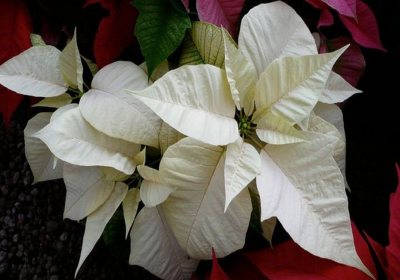 Secondly, it gives an impetus to flowering in young plants, and is carried out as described above. After that, it will be possible to pinch the green parts of the plant when the rudiments of future inflorescences begin to form on the shoots.
Secondly, it gives an impetus to flowering in young plants, and is carried out as described above. After that, it will be possible to pinch the green parts of the plant when the rudiments of future inflorescences begin to form on the shoots.
But remember: if you decide to cut the poinsettia in winter, and not in spring, be sure to supplement it with a phytolamp.
Possible difficulties in growing poinsettia
Withering and then dropping of the leaves. The most likely reason is waterlogging of the soil: the poinsettia plant should be watered when the soil surface is almost completely dry. Of course, insufficient watering, in which the soil near the roots dries up, also leads to wilting and falling leaves.
Leaves can suddenly fall off if the plant is exposed to too low temperatures, or too warm as well as cold, drafts. Leaves that turn yellow may indicate a lack of light or too high a temperature. The leaves are "drooping" - the reason may be hidden in drafts, you need to choose another place for the plant.
Falling inflorescences; yellow or brown leaf edges. The reason is dry air in a warm room. Spray the leaves more often as the poinsettia needs moist air. The flower feels better if a little rubble is poured under the flowerpot. This helps to create the necessary moisture and prevents root rot.
If a large number of leaves are lost, it is necessary to reduce the amount of water, leaving the soil to dry out between waterings. If the poinsettia plant has lost most of the leaves, you need to prune it, put it to rest in a dark, cool place, almost without watering.
The main harm to poinsettia is caused by red spider mites and mealybugs. Treatment with soapy water, in case of severe infection - with actellik. Gray rot - excess moisture and cold air. All damaged parts of the plant should be removed, in case of severe damage, treat with foundation. The plant withers from nearby ripe apples or pears!
Pests and diseases of poinsettia
Among the pests of poinsettia, the most common are:
- whitefly,
- shield,
- spider mite,
- mealybug.

It is easy to get rid of all of them with the help of soap solution, infusions of tobacco, garlic, onions, vodka or alcohol, or industrial insecticides. Treat weekly for a month to kill both adults and larvae, preventing them from laying new eggs.
Major diseases:
- gray rot;
- powdery rot;
- horse rot, or fusarium.
All these are fungal diseases, but they are treated in different ways. With gray rot, which is manifested by a gray bloom and dry brown spots on the leaves and stems, watering is limited, the plant is sprayed with foundation.
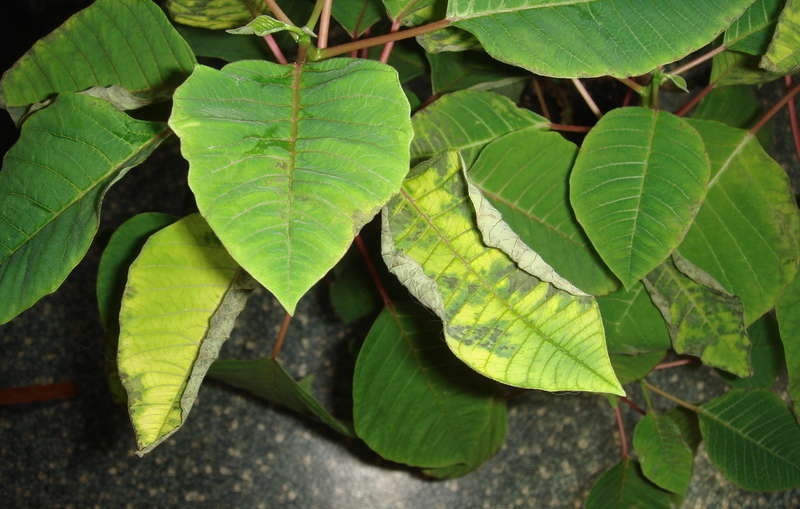
With powdery rot, the plaque is light gray, the aerial parts of the plant are affected. It is treated with phytosporin-M or Topaz.
The hardest part is with fusarium. Here, a transplant will be required with the release of the root system from an earthen coma, removal of the affected roots and treatment of the remaining with a solution of potassium permanganate or antifungal drugs.

Poinsettia care at home
The main difficulties associated with caring for poinsettia are associated with choosing a place where the plant will feel optimally. In addition, it is worthwhile to draw up a calendar of care actions and strictly follow them.
Location and lighting of the flower
In order for the "Christmas star" to live long and bloom regularly, you must follow the conditions for caring for the Poissettia at home after purchase:
- provide it with diffused light, the direct rays of the Sun can burn the leaves of the plant;
- it is best if the flower is placed near a window that faces east or west; otherwise, you need to adjust the shelf with the flower so that the light enters there at an angle;
- the ambient temperature should be approximately the same, protect the plant from cold window panes, euphorbia can freeze its tender, moisture-filled leaves;
- do not open the window over the poissettia, otherwise it will stop growing, and on cold days it can get injured due to low air temperature;
- the location above the heating radiators is guaranteed and will quickly dry out the soil and destroy sensitive roots;
- lighting less than 6 hours a day is not enough for a plant, and if the daylight hours are too short, ultraviolet illumination will be required.
All this means that the most beautiful milkweed has no place on the windowsill. Place it on a well-lit shelf next to a window, but away from the battery. This will make it much easier to care for the flower and ensure its durability.
In the warm season, poinsettia develops well in the open air. The main thing is not to forget to feed and shade it.
The flower begins to form buds at the end of September. At this time, the thief will limit its illumination: for the bracts to turn red, the plant must be illuminated for no more than 10 hours a day. A box or black tight bag will help with this.
Interesting! How to care for a potted money tree
The best ambient temperature will be + 16 ... 17 ° С. This regime should last 2.5 months - until the beginning of December. Then the plant stops shading, and the temperature can be much higher.
In February-March, the hibernation period begins. The beautiful bracts will be shed and new green leaves will appear above them. It's time to carry out pruning, forming a crown, and send the pot to a dark, cool place with a temperature of at least + 10 ° C.
Watered every 2 weeks and do not feed.After 1.5-2 months, you can move the flower to its usual place, having previously transplanted it.
Temperature
The flower is comfortable at a temperature of 18-20 ° C. Most people feel cool in the apartment at this temperature, we are accustomed to 22-26 ° C. This is easy to adjust - you just need to hydrate the plant more.
On the windowsill above the battery, the temperature is much higher. Radiators are heated from 40 to 50 ° C. Warm air rises, and the plant finds itself in extremely unfavorable conditions that cannot be corrected by watering.
In the worst case, such an arrangement can kill the decorative spurge, at the best, it will make the formation of peduncles, and therefore bracts, impossible.
If the temperature in the room is higher than +20 ° С, you can do the following:
- put the pot in a tray with pebbles and in addition to watering the flower, pour some water there: evaporating, the water will cool the roots of the plant;
- place a wide bowl of water next to the flower;
- cover the batteries with wet towels or sheets, this will reduce the temperature in the room by 2-3 degrees;
- Spray the poinsettia with water at room temperature 2-3 times a day.
The method with wet sheets allows you to maintain the conditions in the home that are necessary not only for plants, but also for people. Try it. Perhaps the "Christmas star" will help you better endure the ARI season.
Christmas flower with red leaves: rules for propagation by cuttings
Reproduction by cuttings is one of the most affordable and convenient ways to independently get new flowers in indoor floriculture conditions. Cuttings should have four to five leaves. Immediately after cutting, the cuttings are dipped for about ten minutes in warm, clean water, which will remove the milky juice. Then the cutting needs to be dried a little.
In a flower pot with a volume of a liter, you need to pour a loose and sufficiently fertile soil planting substrate. The soil should be relatively light. Cuttings are dipped in a solution based on "Kornevin", and then planted with a depth of 10 mm in a pot at once, two or three pieces. The rooting process takes about a month. It is not necessary to take care of cuttings especially actively during this period. You can limit yourself to watering. It is best to carry out cuttings from mid-spring to autumn. It was during this period that it was possible to multiply the decorative culture with minimal losses.
Opinions about the flower
How much poinsettia fell in love with plant breeders, you can learn about its features and difficulties of growing from the reviews:
Irina, 26 years old:
Yana, 39 years old:
Olga 32 years old:
Poinsettia is considered a symbol of youth, beauty, health and well-being. She is able to harmonize the atmosphere in the house, bring happiness to a married couple, protect against betrayal, and improve the emotional state. The plant gives joy to all household members, helps to reveal talents, in return, needing only good attitude and proper care, taking into account the subtleties of the main stages of the development of the Christmas star.
Poinsettia diseases and their treatment
Diseases and pests often hit the Christmas star, so every owner should know how to save a beautiful flower from them. If you notice sticky or white waxy spots on the leaves, this means that the plant is parasitized by mealybugs, aphids or whiteflies. Systemic insecticides will help get rid of them. By the way, aphids and scale insects can be removed without special tools.
It is enough to wipe the leaves with soapy water once a week, and after application, gently rinse it off in the shower. As for diseases, the most common are fusarium, powdery mildew and gray rot.
The latter is due to improper care: high humidity and excessive watering. On the inflorescences and stems, a gray plaque resembling mold appears, and the leaves are covered with brown spots. To eliminate rot, use the preparations "Celandine", "Skor" or "Fundazol".The foliage painted in brown-black color indicates that the plant is sick with Fusarium. If spraying is not carried out on time, the leaves curl, wither and die off. A characteristic feature of powdery mildew is a white coating that covers the shoots and bracts. Fungal infections are very dangerous, so when the first signs of the disease appear, treat the plant with Topaz or Fitosporin-M fungicides.
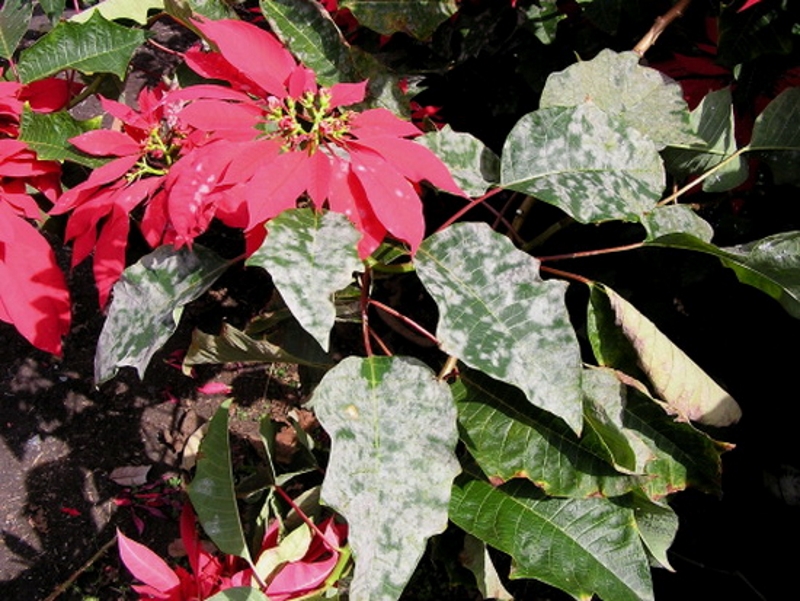
Poinsettia may be susceptible to powdery mildew
Why do leaves fall
Almost all problems are associated with improper care. Growing in a cool room and watering too often can lead to root rot, during which the leaves turn yellow and crumble. Damages to the flower and lack of moisture. It leads to the fact that the poinsettia dries up or is affected by spider mites, so do not forget to humidify the air in a timely manner. By the way, leaf fall does not always indicate a disease. As soon as the Christmas star has faded, it sheds the bracts and goes into a dormant state. This is a natural process, so you should not take any measures in this case. If you know how to properly care for a plant, and clearly follow the recommendations of gardeners, you can avoid such an unpleasant phenomenon - leaf fall.
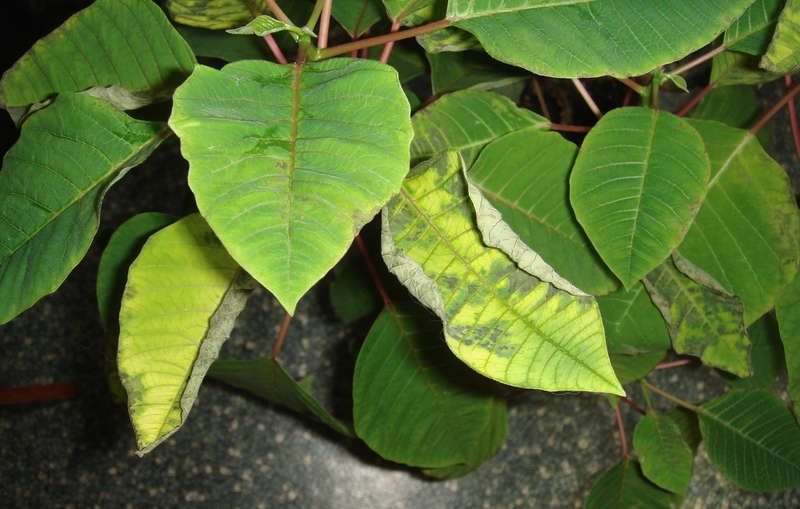
Poinsettia leaves may turn yellow due to insufficient care
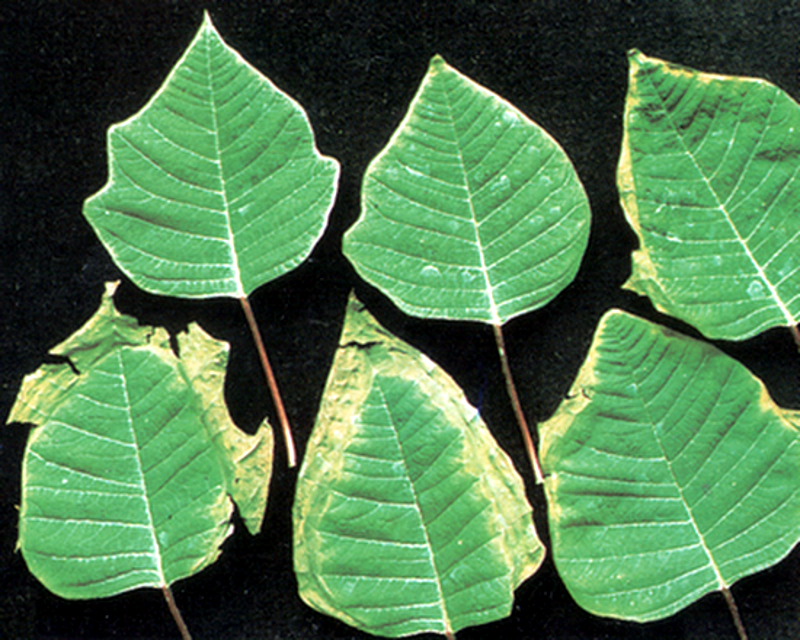
Yellowing and leaf fall can occur due to molybdenum deficiency
Why does not it bloom
If the poinsettia is not blooming or reddening, most likely you missed one of the most important agrotechnical recommendations of experts. For abundant flowering, she needs not only timely watering and spraying, but also compliance with light and temperature conditions. Make sure that the Christmas star does not freeze, cut off weak shoots, wipe the leaves weekly with a damp cloth.

Poinsettia will bloom if you take care of it in a timely manner.
When to replant a Christmas star
After the New Year holidays, the poinsettia enters a dormant period: the leaves wither and fall, the branches become bare. This is a natural process and cannot be avoided even with proper home care. Usually, the flowering of the Christmas tree ends in early spring. The bush is cut at a height of 10 cm from the edge of the pot.

Advice!
If you still have not transplanted euphorbia, then this should be done in March. Prepare light, crumbly soil that does not retain moisture for transplanting. At the bottom of the pot, be sure to pour small pebbles or expanded clay for drainage.
At home, to transplant a flower into a new container, you can use a ready-made soil mixture containing humus, leaf, peat soil and sand. Usually its composition is written on the package with soil.
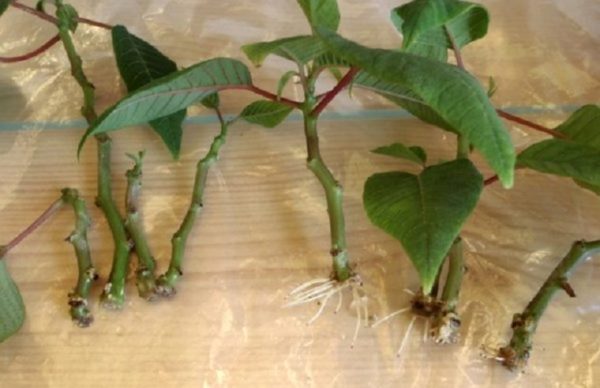
Note!
It is enough to water a newly planted Christmas tree in the first month with clean water at room temperature, fertilizer does not need to be applied, additional care is not required at this time. The plant should take root in the new environment and get stronger.
It is important that the new container into which you transplanted the poinsettia is slightly larger than the previous one. It is enough for its volume to be about one and a half to two times larger than the root itself with a lump of earth
Do not forget that the more soil the pot holds, the longer it dries out.
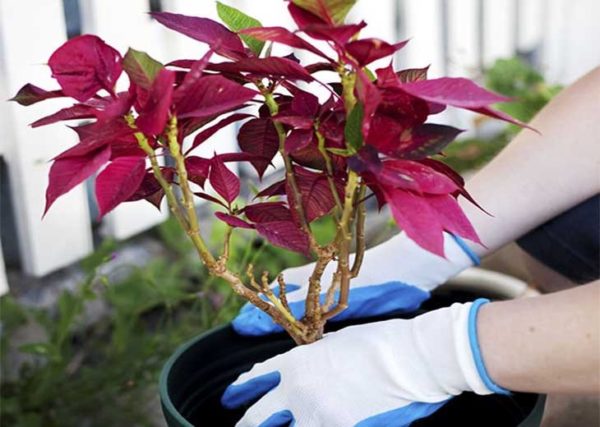
Poinsettia roots do not tolerate waterlogging well, and the flower will be uncomfortable in a spacious dwelling. After transplanting, move the euphorbia to a cool place with minimal watering. Until May, the euphorbia will gain strength for growth, in order to bring joy and inspiration next year.
How to care for poinsettia after purchase
Naturally, after such a wonderful acquisition, you should think about further care. Despite the fact that the poinsettia flower is unpretentious, every grower should become familiar with its characteristic features, as well as the basic care requirements.
How to transplant a poinsettia after purchase
If you bought an indoor flower just before the New Year holidays, then you should postpone the transplant. For the first few days, the plant is not recommended to be touched or rearranged, since it takes some time to acclimatize. During flowering, transplanting is strictly prohibited, because it can cause the loss of bright bracts. Experienced gardeners consider the spring period the best for transplantation. As a rule, by April, the poinsettia wakes up after rest and releases young leaves. The pot should be selected based on the size of the plant, it should be large and spacious. Use slightly acidic soil for transplanting, which consists of leafy, clay-soddy, and peat soil. You can buy a suitable primer at a flower shop. Do not forget about the drainage layer, thanks to which excess moisture will not accumulate in the pot. Transplanting is stressful for the plant, so it is better to carry out it using the transshipment method. Try to keep a clod of earth on the roots so that the bush will quickly take root in a new place. Despite the fact that poinsettia does not bloom in summer, it can become an original decoration for your summer cottage. For the summer period, take the flower to the country and place it in the garden, where it can stay until autumn.

Poinsettia is transplanted by the transshipment method
Lighting, humidity and temperature of the content
Poinsettia needs good lighting, so a flowerpot with it is placed on the east and west windows. If you take care of additional lighting during the winter period, you can slightly extend the flowering. Note that despite the light-requiring, the plant does not tolerate prolonged exposure to direct sunlight. As for the temperature regime, the optimal temperature is +18 - +20 ° C and above. At a value below 14 ° C, the plant dies. Drafts, being in close proximity to heating devices or cold windows will negatively affect the flower. In nature, poinsettia is found exclusively in tropical rainforests. To create conditions as close to natural as possible, you should spray the air around the New Year's flower with warm water daily. Please note that it is undesirable to get water on the leaves, as it can cause white spots. During the dormant period (February-March), spraying is suspended, and in April and May (with the appearance of shoots), they are resumed.

Poinsettia requires good lighting
How to water a poinsettia
The plant needs abundant watering
It is very important to monitor the condition of the soil: it should not be too dry or wet. In winter, it is recommended to use warm water for irrigation, the temperature of which is a couple of degrees higher than the air temperature in the room.
Otherwise, the bush can shed beautiful leaves. Special holes should be made in the pot so that excess water, passing through the substrate and drainage, does not linger in it.
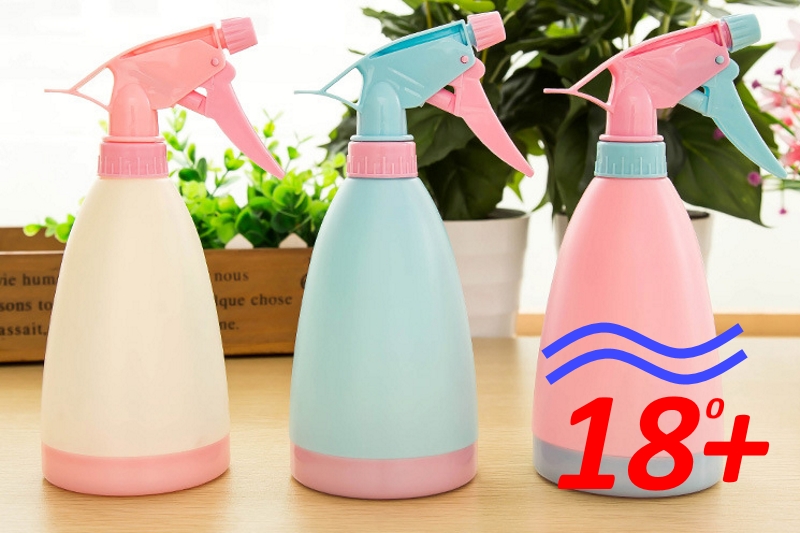
Water the poinsettia with water at a temperature of at least 18 degrees
Top dressing and fertilization
Poinsettia does not require frequent feeding. Moreover, during the period of flowering and dormancy, it is strictly prohibited. Fertilizers can only be added when transplanting the plant, during the appearance of new leaves (spring-summer time), as well as immediately before flowering (October-November). If you have chosen the right soil for transplanting, feeding can be done even less often.
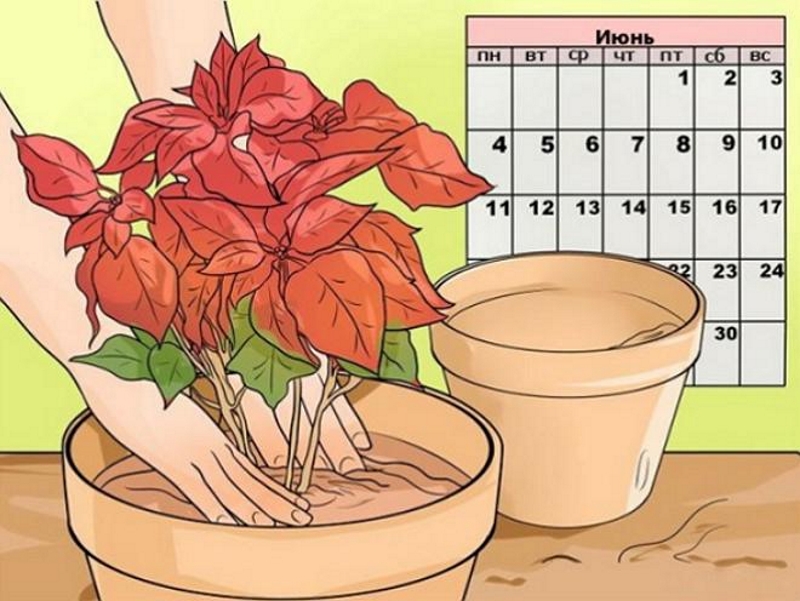
Transplanting and feeding poinsettia takes place in the spring and summer
When and how to prune the plant?
In order for a home flower to have a beautiful and well-groomed appearance, it must be cut in a timely manner. At the end of flowering, the number of buds is halved. In April-May, young shoots appear on the plant. Take a good look at them, leave 5-6 strong on each stem, and carefully cut the rest with garden shears or a sharp knife. Poinsettia can be in the form of a tree or a bush.In the first case, only 1 trunk should be left, and in the second 2-3 powerful stems. As you grow, you can adjust the shape of the plant by pruning it.

By trimming poinsettia to shape its shape
How to choose a poinsettia in a store.
Very often they look at the tops of their heads so that they are larger, larger. You still need to look inside, choose those specimens where the flowers have not yet blossomed. Blooming flowers can be identified by stamens. If the flowers are already with stamens, shriveled, dried, then this plant has been blooming for a long time and it will not be long to please you with its bright appearance. Plants with not yet blossoming buds will retain their colorful appearance for the maximum time.
 Blooming poinsettia flowers, stamens are clearly visible.
Blooming poinsettia flowers, stamens are clearly visible.
In large shopping centers, you can find large tables with a variety of plants installed on them, which, for the convenience of watering, are placed on them using bottom watering through the drainage holes of the pots. Often on such large tables, all the pots are literally in the water. Euphorbia can very quickly suffer from waterlogging, from such excessive watering.
 Yellow poinsettia
Yellow poinsettia
Such a situation often occurs: you buy a poinsettia and for some reason it either does not live long in indoor conditions, dies, or remains to live, but does not bloom. This is due to changing conditions for the plant, especially humidity. From greenhouses with ideal temperature conditions, humidity and illumination, plants go to shops, and then to our homes.
After a while, the plant loses its bright color, it can even shed its leaves. This does not mean that it died. This may be a reaction to the fact that the plant has spent a lot of energy, and if it is in a transport pot, in which there is little soil and, as a result, there are few nutrients.
In this case, the poinsettia must be very tightly cut and transplanted to save it. Here the plant is not up to flowering. What does it mean to cut strongly? Leave 1-2 buds on each stem, everything above needs to be cut off. This vigorous pruning stimulates the growth of new young shoots.


